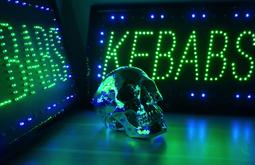“The Gods had condemned Sisyphus to ceaselessly rolling a rock to the top of a mountain, whence the stone would fall back of its own weight. They had thought with some reason that there is no more dreadful punishment than futile and hopeless labour.” - Albert Camus. The Myth of Sisyphus. London: Hamish Hamilton Ltd, 1955. pp 96
"In the twentieth century, literature, often supplemented by mythology, was used as a looking glass through which to examine philosophical subjects. Literature grounds experiences in particular contexts with wide-reaching appeal and relevance, meanwhile the agency of myth is its suggestive, rather than didactic, demonstration of human experience; as well as its functioning in the realm of emotional encounter. This attribute is contained in Shahriar Asdollah-Zadeh’s installation Fear, Faith and Persian Pop, comprising four artworks: two films – Fear performance: The myth of Sisyphus (a documented performance) and Persepolis: What lays in the abyss it has created (a looped short film) – and two sculptures Faith and Fear.
The Greek myth regarding Sisyphus has emerged in various settings as a subject throughout history; for instance Titian’s Sisyphus (c.1548-1549) and Sir Edward Coley Burne-Jones’s Sisyphus (c.1870). As punishment for deceit, Sisyphus was compelled to infinitely roll an immense boulder up a hill, only to watch it roll back down. For the fringe existentialist Albert Camus (1913-1960), Sisyphus’s hopeless quandary was an allegory for the fundamental absurdity of the human condition. Camus proposed that peace for the individual was paradoxically possible via an embrace of one’s own ridiculous plight. Through merging literature with myth, Camus offered a treatise for how life ought to be lived, as he saw it, in the twentieth century. When applied to contemporary culture, Sisyphus’s predicament has correlations to the despondency of a life filled with menial labour and lack of overriding purpose.
For Asdollah-Zadeh, the symbol of Sisyphus is pertinent and topical. Sisyphus provides the backbone for the artist’s exploration of human struggle, political turbulence and migration in Fear, Faith and Persian Pop . Asdollah-Zadeh has picked up and adapted the legacy of Camus to comment on current social issues, arising through economic crisis, rising unemployment and low wages. The artist stands in for Sisyphus in Fear Performance: The Myth of Sisyphus, his predicament set against a backdrop of black sand dunes near Te Henga. The precise location of the dunes in the frame is unclear as they are detached from the site’s surrounding lush Waitākere ranges and dramatic coastline. Instead of pushing a rock, the artist’s Sisyphus drags a sled on which sits a sculpture of the word ‘fear’ made of wood and polystyrene, accentuating the idea that fear is the burden of the modern world, carried in the wake of human discord, debasing emotion."
Excerpt taken from the essay by Zara Sigglekow. Published by Papakura Art Gallery on the occasion of the exhibition FEAR, FAITH AND PERSIAN POP held at Papakura Art Gallery from 26 October to 7 December 2013. Curated by Tracey Williams.

